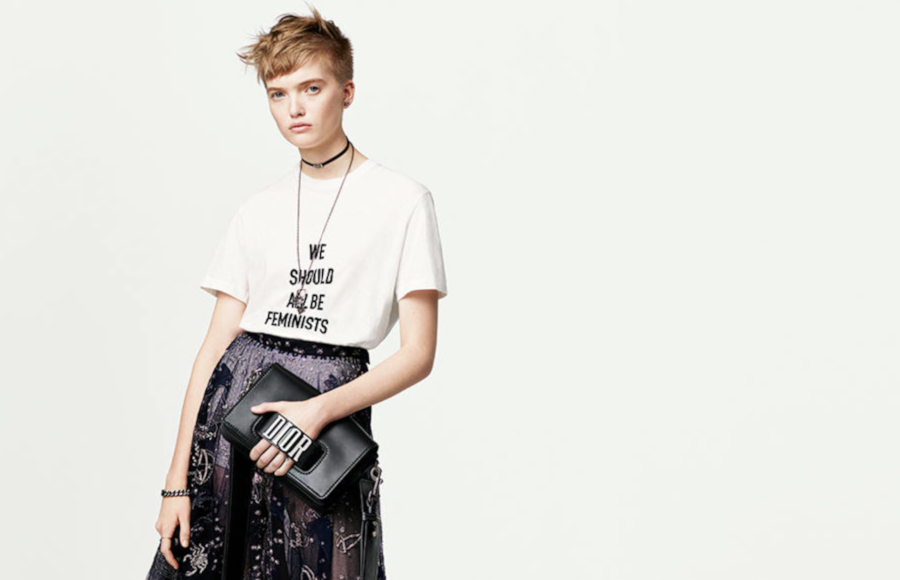
image: Dior
From the increasingly outrageous prices associated with fashion – from runway looks to fast fashion copies – and the small group of individuals that control the narrative and oft-rigid standards of beauty in the fashion industry to the politics of Melania Trump’s wardrobe and fashion’s arguably lax efforts to address the sexual harassment within its ranks, here are just a few of the features we penned in 2017.
1. $20 Jeans, $800 Tees: In Fashion, Prices Are Out of Control. Whether it be $4 shirts from H&M or $800 tees from Dior, prices in fashion are extreme and growing increasingly out of control. A phenomenon that occurs at both ends of the spectrum, with fast fashion and high fashion entities, alike, the proliferation of such pricing disparity appears to symbolize something significant: Consumers have lost touch with how much garments are supposed to reasonably and responsibly cost.
2. Who is Really to Blame When Designers Behave Badly? “Alexander Wang is the pariah of Fashion Week,” wrote the New York Post. A few seasons ago, it was Kanye West in Mr. Wang’s also-adidas shoes. Before that it was Philipp Plein. And quite a while ago, it was Marc Jacobs. “This has become an abusive relationship. To a great extent, fashion and the press have only ourselves to blame.”
3. Deal Dossier: The Battle Over Hermès. Just two hours before the entire world found out that LVMH Moët Hennessy Louis Vuitton had been secretly building up a stake in Hermès in furtherance of what the Birkin bag-maker came to call a “hostile takeover,” Hermès’ then-CEO Patrick Thomas was cycling through France’s rural Auvergne region on a Saturday completely unaware of the mega-storm that had been quietly brewing and was just mere moments away from striking.
4. The Fashion Industry: A Small Club, A Tangled Web of Conflicts. The fashion industry is a complex web of connections – and this might prove to be more of a liability than an asset. Yes, fashion is something of a byzantine ecosystem borne largely from the industry’s failure to look outside of its closest circle of stylists, consultants, journalists, ghostwriters, etc. for talent. The result is a significant overlap of roles – a magazine editor styling a brand’s runway show, a critic writing a brand’s show notes, or the same handful of casting directors determining which models walk in shows during a season. It also ensures that the iron-clad establishment stays in power.
5. If Consumers Are Not Demanding Novelty, Why Should Fashion Deliver? It appears, however, that these passing instances of alleged copying might actually be little more than that – fleeting moments. While such copying call-outs are certainly more visible and well-documented than ever before, thanks to social media, they do not necessarily have a significant impact on a brand’s image or bottom line.
6. This Is Not “Art” or “Fashion,” It is Objectification. While sex does sell – or at least, sells when it is in style, which is frequent – is its hyper-specific depiction, one that almost exclusively serves to objectify women, good for the fashion industry? And better yet, is it good for women in general or does it drive home our larger social sense of sexism and a potential lack of value for women? These are particularly relevant questions in light of the larger conversation about sexual harassment and assault in Hollywood, in fashion, and beyond.
7. As Vogue Continues to Highlight Melania Trump’s Wardrobe, We Ask, Should it Pick a Side? Vogue’s regular coverage of Trump administration fashion/lifestyle matters is noteworthy, as it appears to run afoul of the general sentiment that brands, corporations, and in certain circumstances, even publications, should take a stance on the current administration, in particular – and make that stance crystal clear – in light of Donald Trump’s increasingly offensive views on everything from women’s and LGBT rights to racism and immigration.
8. Twitter, T-Shirt Activism: Cult, Culture, Community but Is it Action? Yes, despite the existence of some truly well-meaning and acting individuals, the activism-centric movement within the fashion industry in recent seasons has, nonetheless, been an immensely complex one, that is, in many ways, lacking.
9. Why is Fashion Lagging Behind in the Fight Against Sexual Harassment? Sexual harassment and mistreatment of models has “always been widely known and tolerated in the fashion industry,” according to Christy Turlington. “The industry is surrounded by predators, who thrive on the constant rejection and loneliness so many of us [models] have experienced at some point in our careers.”
10. A Reflection on Fashion and Inspiration in 2017. 2017 may be the year that we officially lost touch with what it means to operate within the bounds of fashion and its existing mass of prior art. Yes, we have collectively stooped to a lowly level of copycat calling-out – both by way of social media and cease and desist letters, alike – that looks a bit more like bullying than merited legal argument or educational enlightenment, while simultaneously forgetting that fashion is (and has almost always been) inherently derivative.
11. Why Do Ads and Editorials Depicting Violence Happen in Fashion? Violence-centric editorials and ad campaigns are confusing if we consider who, exactly, fashion caters to – most immediately – and who it is largely dependent on. Fashion is an industry that thrives on and thus, caters to, women – and yet, it continues to victimize them.
12. Why Are Designers Leaving New York? And Can We Blame Them? New York Fashion Week has been losing significant names over the past several months, with Thom Browne, Proenza Schouler, Rodarte, and Altuzarra – some of the biggest players in New York fashion – defecting to Paris to show their collections as part of the world’s most prestigious Fashion Week. Industry insiders and journalists, alike, have been quick to question what effect such noteworthy moves will have on the New York Fashion Week calendar and more generally, on New York as a fashion capital.







